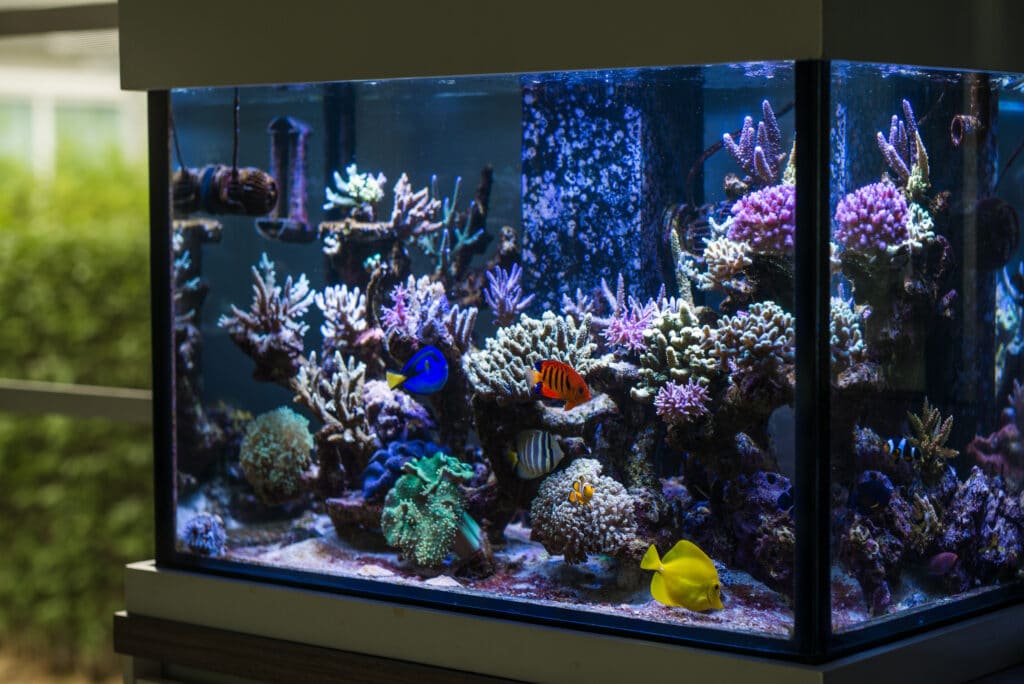Chalice Coral: A Comprehensive Guide for Beginners
Corals are not just beautiful creatures that add color to an underwater world, but they also play a vital role...
Jim Sabellico
January 10, 2022

Finding the best location to set up a reef tank in a home is one of the hardest decisions for a reef tank owner. You can ask tips from your co-reef tank owners but the answers that you’ll get will be different from what you expect, why? Because each one of you has different home layouts and of course different priorities, here are some important tips that will help you in your decision-making.
There are lots of things to consider when choosing the location of a reef tank. The first thing to consider is for the location to get easy access for maintenance, lighting, and air circulation. It’s also important to take note of ifthe location can hold the weight of the reef tank and the people standing beside it. Avoid locations where people in your home usually go like the bedroom and kitchen as the high traffic and vibrations can also cause issues down the line.
In this article, we will talk about the things that will guide you in finding the best location for your reef tanks. These guides are of course done after a lot of trials and error while doing countless maintenance and installations.
We all do our own research to have our own reference in finding the location of our reef tanks. You probably read about these guides multiple times from other posts and they do warrant some thinking.
Here are some of the most common location factors or guides that people talk about:
All of these are important factors, but as you further read this article, we will provide you with guides that will make or break the long-term success of your reef tank.
In finding the best location, we need to consider if it can hold the weight of your reef tank. Why? Because reef tanks can get real heavy.
Water contributes a lot to a reef tank’s weight but most people forget that the substrate and the dry weight of the tank are also factors that affect it.
In an average tank, freshwater will weigh around 9.4lbs in a 1-gallon glass tank and 8.8lbs in a 1-gallon acrylic tank when filled to the brim. While saltwater will weigh around 9.6lbs in a 1-gallon glass tank and 9lbs in a 1-gallon acrylic tank.
You can also use this chart as a reference for the size and weight of the tank that you want to install:
| AQUARIUMVOLUME | SALTWATERWEIGHT | FRESHWATERWEIGHT | EMPTYWEIGHT |
| 5 Gal / 19 liters | 43 lb. / 16 kg | 42 lb. / 19 kg | 7 lb. / 3 kg |
| 10 gal. / 38 liters | 87 lb. / 40 kg | 84 lb. / 38 kg | 11 lb. / 5 kg |
| 15 gal. / 57 liters | 128 lb. / 58 kg | 125lb. / 56 kg | 19 lb. / 9 kg |
| 20 gal. / 76 liters | 172 lb. / 77 kg | 167 lb. / 75kg | 25 lb. / 11 kg |
| 25 gal. / 95 liters | 214 lb. / 96 kg | 209 lb. / 94 kg | 32 lb. / 15 kg |
| 30 gal. / 114 liters | 257 lb. / 116 kg | 250 lb. / 113 kg | 42 lb. / 19 kg |
| 35 gal. / 133 liters | 300 lb. / 150 kg | 292 lb. / 131 kg | 46 lb. / 21 kg |
| 40 gal. / 152 liters | 342 lb. / 154 kg | 334 lb. / 150 kg | 56 lb. / 25 kg |
| 45 gal. / 170 liters | 385 lb. / 173 kg | 375 lb. / 169 kg | 68 lb. / 31 kg |
| 50 gal. / 190 liters | 428 lb. / 193 kg | 417 lb. / 188 kg | 70 lb. / 32 kg |
| 55 gal. / 208 liters | 471 lb. / 212 kg | 459 lb. / 206 kg | 78 lb. / 35 kg |
| 65 gal. / 246 liters | 556 lb. / 250 kg | 542 lb. / 244 kg | 90 lb. / 41 kg |
| 75 gal. / 284 liters | 642 lb. / 289 kg | 626 lb. / 281 kg | 98 lb. / 44 kg |
| 90 gal. / 341 liters | 770 lb. / 346 kg | 751 lb. / 338 kg | 135 lb. / 61 kg |
| 120 gal. / 455 liters | 1027 lb. / 462 kg | 1001 lb. / 450 kg | 191 lb. / 87 kg |
| 150 gal. / 569 liters | 1284 lb. / 578 kg | 1251 lb. / 563 kg | 281 lb. / 127 kg |
| 180 gal. / 682 liters | 1541 lb. / 693 kg | 1501 lb. / 676 kg | 282 lb. / 128 kg |
| 210 gal. / 796 liters | 1798 lb. / 809 kg | 1751 lb. / 788 kg | 343 lb. / 156 kg |
| 240 gal. / 910 liters | 2054 lb. / 924 kg | 2002 lb. / 901 kg | 365 lb. / 166 kg |
| 280 gal. / 1061 liters | 2397 lb. / 1079 kg | 2335 lb. / 1051 kg | 402 lb. / 182 kg |
| 300 gal. / 1137 liters | 2568 lb. / 1156 kg | 2502 lb. / 1126 kg | 446 lb. / 202 kg |
As mentioned above, the water, substrate and the dry tank will contribute to the initial weight of the reef tank but the corals, the occupants and the gadgets are not yet included in this. These factors can help you choose in finding a stable location for the reef tank.
Let’s say you have parties or gatherings in your home. There will be always at least 2 to 4 people that will want to see your reef tank and be amazed by its beauty. You have to make sure that the floor of the location that you will choose can hold 1000-2000 lbs of weight within a 5 ft sq area around your tank. Do not go putting your tank on a shelf because it looks cool. Remember that your tank will weigh around 200lbs and more (depending on how big your tank is and its content) and that shelf might not hold your tank for a long time.
Take note that once a tank is set up, the location is final. It is not something that you can move occasionally just because you want to. If you get the location wrong, you will need to empty the tank before you can move it. All of this process can damage the corals on your tank and can cause stress to its occupants. Moving a tank with any amount of water in it can cause damage to the glass and seams of the tank.
When placing a tank on a stand, the reef tank needs to be completely leveled and the stand seated correctly to evenly distribute the immense weight of the water to the floor. If the tank is not placed correctly, the stand will bow and will place pressure points to the glass of the tank that might cause the tank to burst.
One of the biggest factors for your reef tank’s long-term success is its maintenance. So choosing a location where you have easy access for maintenance is a must because it will prevent your tank from having algae blooms or ammonia spikes.
So here is the list of the installation locations you should try and avoid for your reef tank:
Having easy access to your tank and a sink nearby where there is a water supply is very handy. These little things will make you comfortable to work on your reef tank and do your regular maintenance. After all, the reason you chose this location that gives you the easiest maintenance is to avoid procrastinating.
But not everyone has the time to keep their reef tank neat and tidy so you need to have your maintenance tools and supplies easily accessible but also out of sight. Of course, you also have the choice to spend a few hundred dollars for a few installation gadgets just to make your maintenance a breeze. Just remember, when your maintenance begins to slide, the reef tank will decline and becomes nothing but scraps.
We all love to enjoy the beauty of an underwater world in our home, which is the reason why most reef tank owners place their tanks in their living rooms or inside areas where they spend the most time. Seeing this underwater beauty while sipping your drink is another form of therapy that will help reduce your stress.
Finding the best spot for your maximum viewing pleasure while having the best location for your maintenance is not an easy task. And ultimately, it’s going to be up to you to decide what the right answer for you is, but one thing is for sure it’s a critically important decision that a lot of people don’t spend enough time considering before jumping right in, so be sure to do yourself a favor and give it some thought now, you’ll be happy you did later on.

I am the founder of J. Louis, a digital marketing agency focused on providing innovative solutions and strategies built on a foundation of creative design and technology. A family man who loves travel and reef tanks, I’ve been coined as a jack of all trades, master of a few of them, most specifically website and sales funnel design, monetization and growth strategies, and viral marketing. I began pursuing my passions for business by cutting my neighbor’s lawns when I was just 8 years old and never looked back. Over the past 20 years, I have amassed significant experience providing consulting, design and development services for Fortune 500 companies, government, retail, private individuals, and A-list celebrities.
Corals are not just beautiful creatures that add color to an underwater world, but they also play a vital role...
As we move into the new year, it's time to start thinking about what reef tank LED lighting kits will...

Proceeds from all purchases go directly to Great Barrier Reef Foundation and supporting their mission.
Want to stay connected with all the latest news in the Reef Tank Addict community? Drop your email below!
Proudly Supporting The Great Barrier Reef Foundation
Copyright © 2023. All rights reserved.